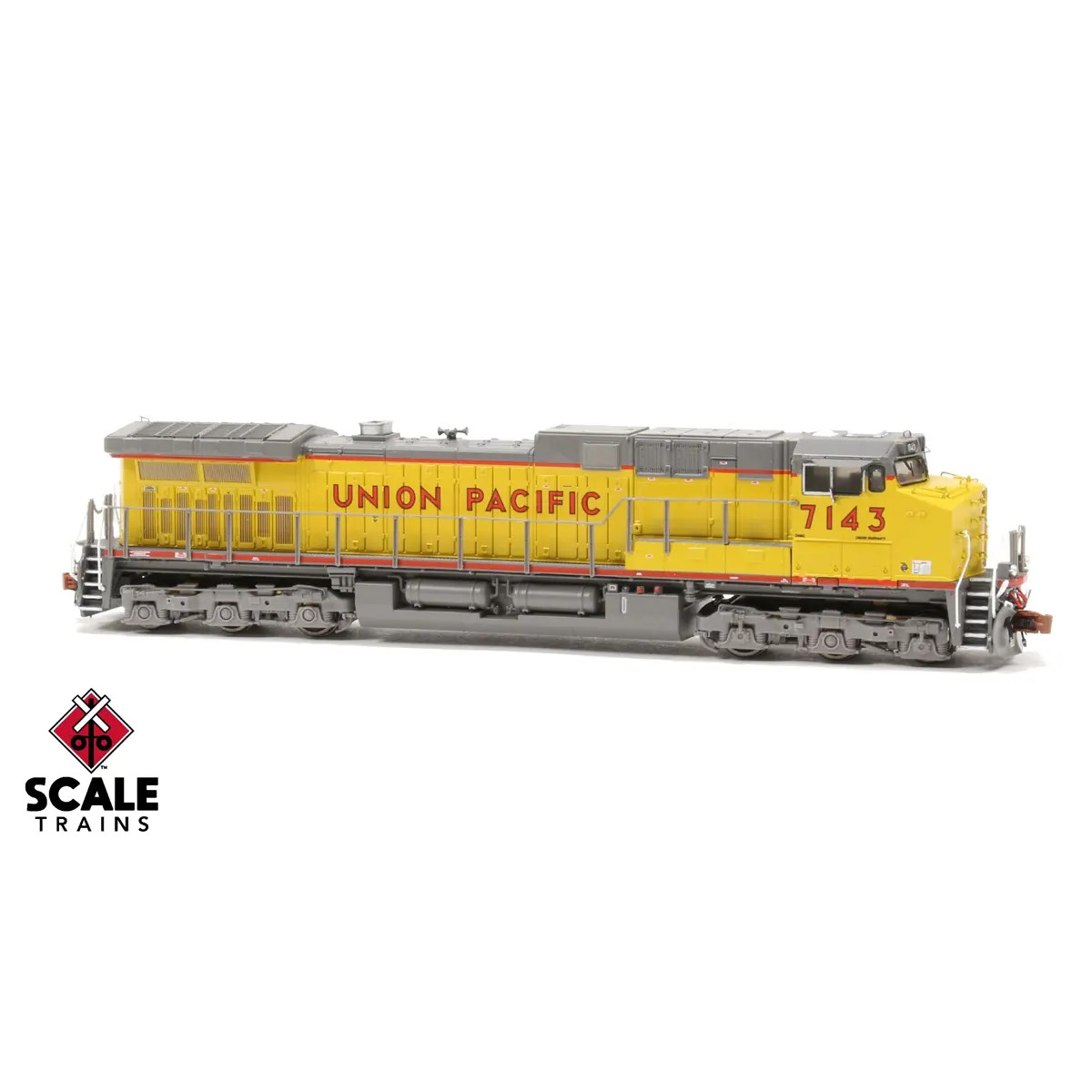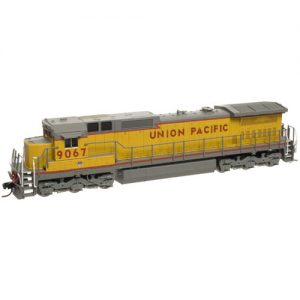Description
Railroad Short Name: UP
Prototype Information:
EMD and GE would soon square off in the development of Alternating-Current, or A.C., traction for locomotives. Prior production models from both builders utilized Direct-Current (D.C.) traction motors for propulsion, as was done since the very first diesel-electric locomotives were produced. A.C. traction motors demonstrated significant advantages over their D.C. counterparts by allowing for much greater continuous tractive effort, as well as reduced maintenance. They were also much more resilient than D.C. motors, and were able to endure much higher short-time ratings (the ability of the traction motors to withstand high amperage at low speeds for a set period of time without incurring damage), giving them extraordinary lugging ability.
A.C. units showed their ability to replace their D.C. predecessors on a 3-to-5 basis, being able to walk away with heavy trains from a dead stop on an upgrade, in scenarios that were nearly impossible with an equivalent number of D.C. units. This wizardry required substantial changes to the locomotive’s electrical system, including a system of electrical inverters to “refine” the current being fed to the traction motors and an extensive microprocessor control system to manage it all. While these changes increased per-unit cost, most railroads found the benefits to be more than worth the expense. With that, EMD would introduce the SD70MAC, and GE the AC4400CW. The AC4400CW was based upon GE’s highly successful Dash 9-44CW design, and would become one of the hottest selling locomotives of the 1990s and beyond.
Initial AC4400CW customers utilized their units in applications best suited for their tremendous lugging ability. Based upon their satisfaction with the DASH 9 fleet and their desire for reliable power to move Powder River Basin coal, the Chicago & North Western (C&NW) was one of the first to purchase the newest A.C. power. Sets of AC4400s, painted in the attractive “Lightning Stripe” variation of their classic green and yellow paint scheme, could be seen all over the Powder River Basin moving seemingly endless strings of coal hoppers or gondolas.
CSX Transportation (CSXT) was another early customer and ordered a sizable fleet of ACs for service in the Appalachian coal fields. Delivered in the attractive yellow, blue, and gray “YN2” scheme, the new units quickly became crew favorites. The new AC4400CWs handily outperformed older locomotive models in their daunting assignment.
Western giant Southern Pacific (SP) stunned the industry with a massive order of 278 units. All were delivered in their longtime gray and scarlet, but with the Rio Grande Industries inspired “Speed Lettering” on their flanks. While SP struggled financially throughout the 1980s, by the 1990s they were seemingly on the rebound, ordering large numbers of high-horsepower, 4-axle units over the previous years, for use on high-speed, high-priority intermodal traffic. However, SP’s 6-axle heavy-haul fleet had languished over the years, and the ACs were a much-needed shot in the arm. A.C. power allowed SP to handle growing amounts of bulk traffic (coal, minerals, crude oil, and grain) across the system.
Enticed by the promises of improved train handling and reduced maintenance costs, more and more railroads took notice and joined the A.C. revolution. Eventually, as operating practices evolved, ACs would find themselves in services beyond the heavy-tonnage applications they were originally envisioned for. As piggyback traffic dwindled and heavier double-stack container trains became more prevalent, AC4400s started finding their way onto those trains, where again their performance characteristics proved their value. As older power was retired or cascaded down into more secondary duties, ACs were finding themselves on just about every service on the railroad.
By the time domestic AC4400 production ended in 2004, nearly every Class 1 railroad had ordered examples of AC4400s except for Norfolk Southern (NS). Ever the holdout, NS avoided safety cabs and AC-traction as long as possible. Instead, they would purchase standard-cab DASH 9s as well as large numbers of its safety-cab equipped version, the C40-9W. Into the 2000s however, NS would eventually acquire AC-traction locomotives, and were impressed with their performance. So much so, they would embark on a rebuilding and upgrading program for their older DASH 9 locomotives, dubbing them “AC44C6M” (AC traction, 4,400hp, C for six axles, the number 6 to signify the number of traction motors, and M for “Modified”). They would have their cabs replaced with the latest GE safety cab design, plus new electrical systems, and components upgraded to AC4400 standards.
Features:
- All-new model
- Era: 1997 to Early-2000s
- Series 7143 to 7244, built 10/97
- Road numbers 7143, 7150 and 7157
- Red sill stripe
- Fully-assembled
- LED-illuminated front deck-mounted ditch lights
- LED-illuminated high-mount cab number boards*
- Directional LED-illuminated headlights
- Painted and factory-applied detail parts: wire grab irons; trainline hoses with silver gladhands; 3-hose MU clusters with silver gladhands; MU cable, uncoupling levers; windshield wipers; mirrors; sunshades; brake wheel; and more
- Tall snowplow with open doors and grab irons
- Semi-scale Type E knuckle couplers – Micro-Trains® compatible
- Body mounted coupler box – accepts Micro-Trains® 1015/1016 type couplers without modification
- 5-step stepwells
- Walkway with front anticlimber
- GE “nub” pattern walkway tread
- Narrow profile end handrails
- Nose door without window
- Two-piece nose top grab irons
- Front LED-illuminated headlight with lenses on low short hood (low headlight)
- Battery cabinet access door without latch
- GE safety cab with three (3) side windows
- Right side cab under floor access doors: dual large louver panels per door
- Left side cab under floor access doors: dual latch door with grille forward of the HVAC unit
- Detailed cab interior with floor, rear wall, seats, and desktop
- Tinted cab side windows
- Antennas
- Octagonal antenna dome with small square dome
- Early: six (6) tall vertical rectangular bolted panels and three (3) horizontal short panels
- Continuous reinforcement rib under dynamic brake intake grilles
- Standard dynamic brake exhaust (2-port)
- Forward right-side air intake grille
- Left side auxiliary cab: three (3) medium doors with latches on the #2 door
- Capacitor box on left side walkway
- Right side auxiliary cab: four (4) doors with latches on #1 and #4 doors
- Late angled engine cab profile with tri-fold power assembly access doors
- Lost-wax brass cast Nathan AirChime K3LAR2 horn mounted on engine cab
- “Bathtub” exhaust silencer
- 2 individually applied etched metal radiator exhaust grilles.
- Right side late radiator door grilles in alternating heights
- Standard brake wheel
- Left rear hood door grille arrangement: tall, short, tall grilles
- Low-mounted rear sandfiller
- Early “box” lifting lugs on ends of radiator wings
- Rear LED-illuminated vertical headlight with lenses
- Accurately profiled frame with separately applied plumbing and traction motor cabling
- GE Hi-Ad trucks with separately applied brake cylinders and air plumbing
- Dual Graham-White (Salem) 824-100 centrifugal air filters
- No air dryer
- 5,000 gallon fuel tank
- Single fuel fills per side
- Round and vertical analog fuel gauges; digital fuel gauges
- Fuel tank mounted steel bell
- Separate air tanks with lower mounting brackets, connector pipe, and connector pipe cover
- Early square handbrake chain bracket
- Spare coupler knuckle holders on rear pilot face
- Motor with 5-pole skew wound armature
- Dual flywheels
- All-wheel drive
- All-wheel electrical pick-up
- Printing and lettering legible under magnification
- Operates on Code 55 and 80 rail
- Minimum Radius: 9 ¾”
- Recommended Radius: 11”
DC Features:
- Operates on DC layouts
- DCC ready with E24 connector







Reviews
There are no reviews yet.